
Devichye Pole
Encyclopedia
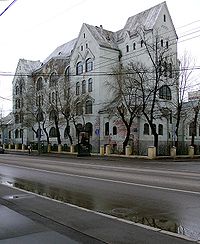
Moscow
Moscow is the capital, the most populous city, and the most populous federal subject of Russia. The city is a major political, economic, cultural, scientific, religious, financial, educational, and transportation centre of Russia and the continent...
, Russia
Russia
Russia or , officially known as both Russia and the Russian Federation , is a country in northern Eurasia. It is a federal semi-presidential republic, comprising 83 federal subjects...
, to the master plan of Konstantin Bykovski. It is located between the Garden Ring
Garden Ring
The Garden Ring, also known as the "B" Ring , is a circular avenue around the central Moscow, its course corresponding to what used to be the city ramparts surrounding Zemlyanoy Gorod in the 17th century....
and Novodevichy Convent
Novodevichy Convent
Novodevichy Convent, also known as Bogoroditse-Smolensky Monastery is probably the best-known cloister of Moscow. Its name, sometimes translated as the New Maidens' Monastery, was devised to differ from an ancient maidens' convent within the Moscow Kremlin. Unlike other Moscow cloisters, it has...
. Originally the medical department of Moscow State University
Moscow State University
Lomonosov Moscow State University , previously known as Lomonosov University or MSU , is the largest university in Russia. Founded in 1755, it also claims to be one of the oldest university in Russia and to have the tallest educational building in the world. Its current rector is Viktor Sadovnichiy...
, it is now split between Moscow Medical Academy
Moscow Medical Academy
I.M. Sechenov First Moscow State Medical University is the oldest and the largest national medical higher educational institution in the Russian Federation. For more than 250 years I.M. Sechenov First Moscow State Medical University, previous name - I.M. Sechenov First Moscow Institute of...
, Russian State Medical University and various state and private clinics. The territory also includes Russian State Archives and Devichye Pole park.
History

Early history
Devichye Pole acquired its name from Novodevichy Convent (established 1524). In 17th century, it housed a court garden for medicinal herbs, and later the court of Eudoxia LopukhinaEudoxia Lopukhina
Tsarina Evdokiya Feodorovna Lopukhina was the first wife of Peter I of Russia. They married in 1689 but divorced in 1698...
, estranged first wife of Peter I
Peter I of Russia
Peter the Great, Peter I or Pyotr Alexeyevich Romanov Dates indicated by the letters "O.S." are Old Style. All other dates in this article are New Style. ruled the Tsardom of Russia and later the Russian Empire from until his death, jointly ruling before 1696 with his half-brother, Ivan V...
. Thus, the main street (now Bolshaya Pirogovskaya) was called Tsarytsinskaya. In late 18th century, Trubetskoy
Trubetskoy
Trubetskoy , Трубецкой , Трубяцкі , Trubecki , Trubetsky , Трубецький , Troubetzkoy , Trubezkoi or Trubetzkoy , is a Ruthenian Gediminid gentry family of Black Ruthenian stock, like many other princely houses of Grand Duchy of Lithuania, later prominent in Russian...
, Apraksin and other families set their country estates in Devichye Pole; the place remained a quiet country until 1880s.
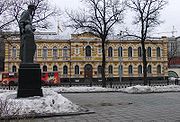
Mikhail Pogodin
Mikhail Petrovich Pogodin was a Russian historian and journalist who, jointly with Nikolay Ustryalov, dominated the national historiography between the death of Nikolay Karamzin in 1826 and the rise of Sergey Solovyov in the 1850s. He is best remembered as a staunch proponent of the Normanist...
, once the center of Moscow literary elite. Extant building is actually a side wing of a larger wooden estate. In 1882-1886, Tsaritsynskaya street acquired a two-story Archive Building, now the exhibition hall of Central Archive of Ancient Acts.
Medical Campus, 1884-1897
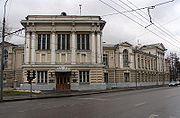
Need for new hospitals for the public and training facilitied for Moscow State University was imminent since 1870s. Proposals by professor Novatsky (1873) and Varvara Morozova (1882) were left unfulfilled, but in 1884 the initiative of professor Nikolay Sklifosovskiy
Nikolay Sklifosovskiy
Nikolai Vasilyevich Sklifosovsky was a Russian surgeon and physiologist of Ukrainian origin. He was born near the town of Dubasari, which is now in Transnistria. Sklifosovsky was a professor of medicine in Saint Petersburg and Kiev...
was approved by the City Hall. City issued free land in Devichye Pole (originally, 18 hectare
Hectare
The hectare is a metric unit of area defined as 10,000 square metres , and primarily used in the measurement of land. In 1795, when the metric system was introduced, the are was defined as being 100 square metres and the hectare was thus 100 ares or 1/100 km2...
s ), national government set aside 2 million roubles, the rest came from private sponsors (notably, Morozov, Khludov and Shelaputin families). University board picked Konstantin Bykovsky by internal vote, instead of a public contest, saving time and ensuring architect's dependence. Professors Alexander Makeyev, Fyodor Erismann, Vladimir Snegirev and Nikolay Sklifosovskiy and Bykovsky formed the project management board. In 1884-1885, Bykovsky, Erismann and Snegirev travelled Europe, inspecting the best institutions of their time. Master plan was ready by the end of 1885, but the national government released its share 2.15 million roubles only in July 1887. Thus, state-funded construction lagged behind private-funded clinics.
The campus was lined along Bolshaya Tsaritsynsksya (now Bolshaya Pirogovskaya) Street, with state-funded clinics on the right (north) side and privately-funded clinics on the left. This explains the difference in architecture - right side is uniformly Neoclassical
Neoclassical architecture
Neoclassical architecture was an architectural style produced by the neoclassical movement that began in the mid-18th century, manifested both in its details as a reaction against the Rococo style of naturalistic ornament, and in its architectural formulas as an outgrowth of some classicizing...
, left side varies from pure Palladian architecture
Palladian architecture
Palladian architecture is a European style of architecture derived from the designs of the Venetian architect Andrea Palladio . The term "Palladian" normally refers to buildings in a style inspired by Palladio's own work; that which is recognised as Palladian architecture today is an evolution of...
to Beaux Arts and Russian Revival
Russian Revival
The Russian Revival style is the generic term for a number of different movements within Russian architecture that arose in second quarter of the 19th century and was an eclectic melding of pre-Peterine Russian architecture and elements of Byzantine architecture.The Russian Revival style arose...
fantasies.
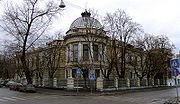
Roman Klein
Roman Ivanovich Klein , born Robert Julius Klein, was a Russian architect and educator, best known for his Neoclassical Pushkin Museum in Moscow. Klein, an eclectic, was one of the most prolific architects of his period, second only to Fyodor Schechtel...
-designed Gynecology Institute (1896) and Pirogov monument by Vladimir Sherwood
Vladimir Osipovich Sherwood
Vladimir Osipovich Sherwood was a Russian architect who worked in Moscow. He was an Eclectics and Russian Revival practitioner, author of the State Historical Museum in Moscow. He was the son of Joseph Sherwood, an English engineer hired to build canals in Russia; the father died when Vladimir...
(1897). The project was unique to Russia and widely praised overseas: for the first time in national history, a large medical institution was designed and built with virtually no limitation in funds and land, so Bykovsky provided a generous margin for future expansion.
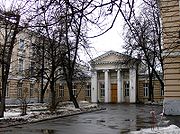
Pyotr Gannushkin
Pyotr Borisovich Gannushkin was a Russian psychiatrist, a pupil of Korsakoff and Serbsky.Moscow psychiatric hospital no.4 and a river embankment in Moscow are named in his honor.-Books:...
working there. This was followed by professor Snegirev's Gynecology clinic in 1889, funded by Morozov and Nosov families. This clinic was later built out from two to four-story, Snegirev monument by Sergey Konenkov
Sergey Konenkov
Sergey Timofeyevich Konenkov was a famous Russian and Soviet sculptor. He was often called "the Russian Rodin".-Early life:...
installed in 1967. Other privately-owned clinics followed, some linked to personal tragedies in sponsors' family life (Khludov and Bazanova endowments, 1896). An orphanage, paid for by Nikolai Mazurin and designed by Illarion Ivanov-Schitz
Illarion Ivanov-Schitz
Illarion Ivanovich Ivanov-Schitz was a Russian architect, notable for developing a unique personal style, blending the Vienna Secession school of Otto Wagner with Greek Revival features. His career peaked in 1902-1912 with several Moscow buildings including the Morozov Hospital, the Merchant Club...
was completed in 1895 (now housing Embassy of Vietnam
Vietnam
Vietnam – sometimes spelled Viet Nam , officially the Socialist Republic of Vietnam – is the easternmost country on the Indochina Peninsula in Southeast Asia. It is bordered by China to the north, Laos to the northwest, Cambodia to the southwest, and the South China Sea –...
). The last building of the first stage was the University Outpatient Clinic, funded by Varvara Alekseyeva, now housing the main building of Sechenov
Ivan Sechenov
Ivan Mikhaylovich Sechenov near Simbirsk, Russia – , Moscow), was a Russian physiologist, named by Ivan Pavlov as "The Father of Russian physiology"...
Moscow Medical Academy.
Campus Church, 1897
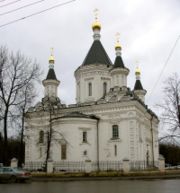
Obstetrics
Obstetrics is the medical specialty dealing with the care of all women's reproductive tracts and their children during pregnancy , childbirth and the postnatal period...
department (initial outlay alone was 100.000 roubles), and late E.V. Solovyova, also an obstetrician. Makeyev commissioned architect M.I. Nikiforov who earlier built the same department building. Konstantin Bukovsky, chief architect of the campus, approved Nikiforov's design and is sometimes credited with it, erroneously; however, the church indeed is very close to Bykovsky's own work. The church, opened in 1897, became Moscow State University second temple, after Saint Tatiana's. The "road of life" between Archangel Michael, by the obstetrics clinic, and St. Dmitry by the morgue, was an unexpected addition to Bykovsky's plan.
The church was looted in 1922 and closed in 1931; soon, it was converted to a library, than a warehouse, losing the tented roof
Tented roof
A tented roof is a type of roof widely used in 16th and 17th century Russian architecture for churches. It is like a polygonal spire but differs in purpose in that it is typically used to roof the main internal space of a church, rather than an auxiliary structure...
s and all interior trim. In 1977, the city started demolition, destroyed the apse
Apse
In architecture, the apse is a semicircular recess covered with a hemispherical vault or semi-dome...
and northern chapel; public intervention saved the rest of the building, which was eventually rebuilt to original design in 1997-2002.
Cancer Hospice, 1898-1903
This section is based on official "History of Moscow Herzen Oncology Institute"In 1898, oncologist Lev Levshin (1842–1911) called the Board of University to set up an institution caring for the incurable patients. First installment of 150.000 roubles, again, was paid by Morozov family. The result, Moscow Oncology Institute, was built in 1903 in Pogodinskaya Street in pseudo-Russian style. The same year, it acquired its first radium
Radium
Radium is a chemical element with atomic number 88, represented by the symbol Ra. Radium is an almost pure-white alkaline earth metal, but it readily oxidizes on exposure to air, becoming black in color. All isotopes of radium are highly radioactive, with the most stable isotope being radium-226,...
sample from Marie
Marie Curie
Marie Skłodowska-Curie was a physicist and chemist famous for her pioneering research on radioactivity. She was the first person honored with two Nobel Prizes—in physics and chemistry...
and Pierre Curie
Pierre Curie
Pierre Curie was a French physicist, a pioneer in crystallography, magnetism, piezoelectricity and radioactivity, and Nobel laureate. He was the son of Dr. Eugène Curie and Sophie-Claire Depouilly Curie ...
. A state-of-the-art clinic for its time, the institute originally had only 65 beds. After the revolution, the hospice service was cut off; eventually, all hospital beds relocated to another building. As of today, the 1903 building is scheduled for a complete reconstruction.
Second stage, 1905-1914
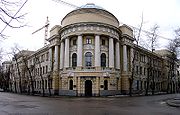
The second round of Devichye Pole development focused on educational, rather than hospital, functions. After the Russian Revolution of 1905
Russian Revolution of 1905
The 1905 Russian Revolution was a wave of mass political and social unrest that spread through vast areas of the Russian Empire. Some of it was directed against the government, while some was undirected. It included worker strikes, peasant unrest, and military mutinies...
, the City and businesspeople realized the imminent social danger of growing disparity in overcrowded cities and focused on education for the masses. Devichye Pole, already having the necessary infrastructure, provided plenty of free land for the new institutions.
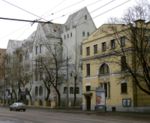
Alexander Zelenko
Alexander Ustinovich Zelenko , 1871–1953, was a Russian and Soviet architect and educator, a pioneer in settlement movement and vocational education...
and Ivan Kondakov
Ivan Kondakov
Ivan Kondakov was a chemist of Russian heritage working in Estonia, who, as professor of pharmacology of University of Tartu, studied polymerisation and invented synthetic rubber in 1901.- Sources :* Estonica: * Postimees 23 May 2009:...
built the modernist City Kindergarten in 1911.
At the same time, outskirts of Devichye Pole began attracting real estate developers. In 1914, shortly before World War I
World War I
World War I , which was predominantly called the World War or the Great War from its occurrence until 1939, and the First World War or World War I thereafter, was a major war centred in Europe that began on 28 July 1914 and lasted until 11 November 1918...
, an eight-story Cloudbreaker (Тучерез) apartment building was started at the northern end of the campus. Despite the war, it was completed in 1917. The building, at Malaya Pirogovskaya, 16, is sometimes mistaken for stalinist architecture
Stalinist architecture
Stalinist architecture , also referred to as Stalinist Gothic, or Socialist Classicism, is a term given to architecture of the Soviet Union between 1933, when Boris Iofan's draft for Palace of the Soviets was officially approved, and 1955, when Nikita Khrushchev condemned "excesses" of the past...
.
Modern History
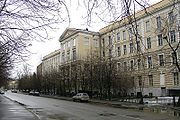
Constructivist architecture
Constructivist architecture was a form of modern architecture that flourished in the Soviet Union in the 1920s and early 1930s. It combined advanced technology and engineering with an avowedly Communist social purpose. Although it was divided into several competing factions, the movement produced...
, are still in good shape, others are falling apart. Later, in 1930s-1950s, the state built two stages of Russian State Archives in Bolshaya Pirogovskaya on the site of former wooden hospital wards - the grey 1930s postconstructivist
Postconstructivism
Postconstructivism was a transitional architectural style that existed in the Soviet Union in the 1930s, typical of early Stalinist architecture before World War II. The term postconstructivism was coined by Selim Khan-Magomedov, a historian of architecture, to describe the product of avant-garde...
building and the yellow, massive stalinist building after the war. The campus itself expanded in 1970s with a massive highrise inserted in the back alley of old surgery clinic. Between 1937 and 1972, Devichye Pole acquired 8 new monuments - 7 to famous doctors and Leo Tolstoy
Leo Tolstoy
Lev Nikolayevich Tolstoy was a Russian writer who primarily wrote novels and short stories. Later in life, he also wrote plays and essays. His two most famous works, the novels War and Peace and Anna Karenina, are acknowledged as two of the greatest novels of all time and a pinnacle of realist...
.
Some old clinics on the left side are in state of disrepair, however, campus facade on Bolshaya Pirogovskaya Street seems to be immune from destruction. The only building torn down in 2006 was a lowrise constructivist addition; a 13-story apartment block replacing it is now at earth pit stage. Beyond Pirogovskaya street, anything is in danger. In 2002, Trubetskoy estate on Usacheva Street was torn apart after arson
Arson
Arson is the crime of intentionally or maliciously setting fire to structures or wildland areas. It may be distinguished from other causes such as spontaneous combustion and natural wildfires...
in 2001, and replaced with an enlarged concrete replica. At this moment (March 2007), the industrial center of Khamovniki, just south from the campus, is one large construction site (note construction cranes in the photographs).
External links
- Moscow Medical Academy: Campus map (only MMA buildings shown) www.mma.ru
- Russian State Medical University www.rgmu.ru
- Russian: History of Devichye Pole www.pravoslavie.ru
- Russian: Church of Archangel Michael www.pravoslavie.ru

